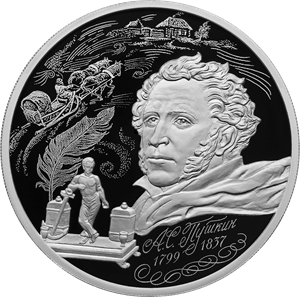The 225th Anniversary of the Birth of Alexander Pushkin
Obverse
a relief image of the National Coat of Arms of the Russian Federation, above it along the rim the inscription in a semicircle ‘РОССИЙСКАЯ ФЕДЕРАЦИЯ’ (RUSSIAN FEDERATION) framed with paired diamonds on both sides, under the coat of arms are the chemical symbol and fineness of the metal on the left and fine metal content and the mint mark on the right, at the bottom centre in three lines are the inscription ‘БАНК РОССИИ’ (BANK OF RUSSIA), the coin denomination ‘3 РУБЛЯ’ (3 RUBLES), and the year of issue ‘2024 г.’ (2024).
Reverse
relief images of Alexander Pushkin’s portrait and an inkpot and images of the scene from a winter trip and a feather, laser treated for matte finishing; and the inscription ‘А.С. Пушкин’ (Alexander Pushkin), the years of the poet’s birth and death ‘1799’ and ‘1837’ and a decorative ornament under the portrait.
Authors
Designers: E.V. Kramskaya (obverse), S.V. Sutyagin (reverse).
Sculptors: A.A. Dolgopolova (obverse), A.V. Gnidin (reverse).
Mint: Saint Petersburg Mint (СПМД).
Edge: 300 corrugations.
Discover more
Alexander Pushkin (1799–1837) was a Russian poet considered the founder of modern Russian literature and the creator of the modern Russian literature language.
In his early verses – a poet of the lyceum brotherhood, admirer of freedom, joy, grace and intelligence; in his early poems – a singer of love and freedom: Ruslan and Ludmila and the romantic poems of the ‘southern cycle’ The Prisoner of the Caucasus, The Fountain of Bakhchisaray, and others. Freedom-loving and anti-tyrannical themes of his early lyrics and his independent personal behaviour were the reasons for his exile: in 1820–1824, the poet was banished to a southern province (Yekaterinoslav, the Caucasus, Crimea, Kishinev, and Odessa) and, in 1824–1826, Pushkin was sent to the Mikhailovskoye village.
With a wide variety of the genres and styles he created (including the ‘unadorned’ prose of The Belkin Tales, the story The Queen of Spades and other works predating the development of realistic writing), the delicacy, elegance and fineness of his verses, the sophistication and strength of the characters he created, ‘enlightened humanism’, and the versatility of his poetic thinking and personality, Alexander Pushkin was destined for greatness in Russian literature that was recognised, owing to his talent, at the global level.
The verse novel Eugene Onegin depicts the lifestyle and the inner world of the typical character rejecting Byronism and the mode of life of the upper-class society of the capital and provinces. In this novel and his many other works, Pushkin addresses such issues as individualism and the boundaries of freedom.
He was the first to identify (in poems, plays and prose) many key problems of Russian literature of the 19th century, quite frequently involving tragic confrontation and intractability – people and authorities, the state and the personality, the role of a personality and people in the history: the tragedy Boris Godunov, the poems Poltava and The Bronze Horseman, and the novel The Captain’s Daughter. In his philosophical lyrics of the 1830s, the so-called ‘little tragedies’ (Mozart and Salieri, The Stone Guest, and the Covetous Knight), Pushkin complemented the topics of friendship, love, poetry of life, recognition of creative works, and memories he always addressed in his verses by the fundamental issues of the meaning and justification of life, death and immortality, salvation and moral purification.
Source: Brief Russian Encyclopaedia [in 3 vol.] / Comp. V. M. Karev. Vol. 2. K–R. – Moscow: Great Russian Encyclopaedia, ONYX 21 Century, 2003.


